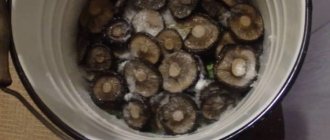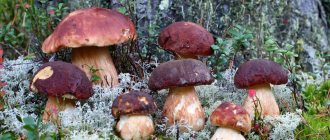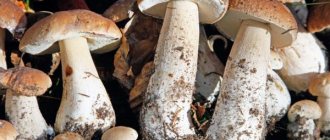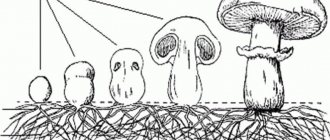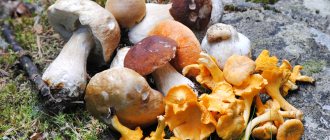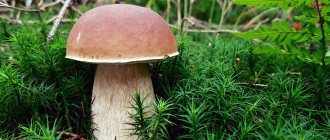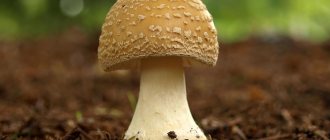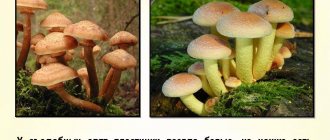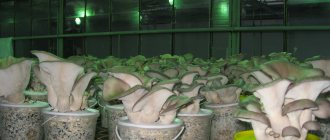About the strange, ancient and mysterious Kingdom of Mushrooms, its history and role in the life of our planet. A unique place in the Kingdom of Mushrooms between the worlds of animals and plants. About the structure, methods of nutrition and reproduction of representatives of the mushroom kingdom.
The world in which we live is a huge single organism in which millions of diverse living beings live. One of them is mushrooms - strange creatures of nature, which at the same time combine qualities inherent in both plants and animals. Science for a long time classified them as part of the plant kingdom, until scientists realized that mushrooms are such special creatures that they fully deserve to be allocated to their own special Kingdom of Mushrooms. The territory of this kingdom is still not fully explored - its far borders have yet to be discovered by science. To date, more than 100,000 species of mushrooms have been openly and scientifically described, but it is known that there are at least three times more of them. Almost a thousand new species are described every year.
The Kingdom of Mushrooms has spread its spaces everywhere - there is no such large or small corner of our world where its representatives do not grow. Most of them live on land. As a rule, in an ordinary forest litter, up to 90% of the biomass of all microorganisms comes from fungal mycelium (about 5 tons per hectare).
Terminology
The international name for the Kingdom of Fungi is Fungi, a modern derivative of the Greek-Latin word meaning “having a spongy structure.” Hence the well-known term “fungotherapy” – treatment using mushrooms. And from the Latin synonym of this term – Mycota came the name of the science “mycology”, which deals with the study of mushrooms.
Fungi are heterotrophic eukaryotic organisms that have an exclusively osmotrophic type of nutrition. That is, these are organisms whose cells contain a separate nucleus, are not capable of obtaining nutrients through photosynthesis, like plants, but are forced to extract them from the external environment, which they do by absorption.
The consequence of this arrangement is the following features of their life activity:
- The vegetative body of fungi is usually a mycelium or single-celled thallus, completely immersed in the substrate, which ensures the most efficient extraction of nutrients over the entire surface of their body.
- The immersion of the thallus in the substrate causes difficulties with reproduction, therefore the spore-bearing organs of most fungi are carried above the surface of the substrate, often with the formation of complex structures - fruiting bodies.
- The substrate often contains nutrients in the form of biopolymers - proteins and polysaccharides, unsuitable for direct absorption through cell membranes. Therefore, the mycelium releases hydrolases or depolymerases into the environment, which perform the functions of digestive enzymes.
- To absorb water and nutrients from the environment, fungal cells create significantly higher internal pressure than the cells of other eukaryotic organisms.
The ground stank of rotten eggs
The smell of the Earth is definitely not pleasant.
When we talk about what the planet was like, we are guided not only by guesses and theories. Scientists are almost certainly confident that they know what the planet smelled like in the past. If anyone had sniffed the air 1.9 billion years ago, they would have clearly detected the smell of rotten eggs.
This is because the oceans were full of gaseous bacteria that fed on the salt in the seawater. The bacteria took the salt and released hydrogen sulfide, filling the air with the characteristic stench we associate with eggs that are gone.
And these scientists are still trying to express themselves more softly. Let's be honest - we have creatures that release hydrogen sulfide into the air every day. You could say that the world of the past smelled like farts.
If you are interested in science and technology news, subscribe to us on Google News and Yandex.Zen so as not to miss new materials!
Between Tree and Lion
The kingdom of Mushrooms occupies an intermediate position between the kingdoms of plants and animals, since its representatives combine properties characteristic of both plant and animal forms of life.
Common with plants:
- The presence of a well-defined cell wall.
- Immobility in a vegetative state.
- Reproduction using spores.
- The ability to synthesize vitamins.
- Absorption of food by absorption (adsorption).
Common with animals:
- Heterotrophy is the inability to synthesize organic substances from inorganic ones through photosynthesis or chemosynthesis.
- The presence of chitin in the cell wall, characteristic of the exoskeleton of arthropods.
- Absence of chloroplasts and photosynthetic pigments in cells.
- Using glycogen as a reserve substance.
- Formation and release of a metabolic product - urea.
All these characteristics of the life activity and structure of fungi allow us to consider them one of the most ancient groups of eukaryotic (having a separate nucleus in the cell) organisms. Moreover, it becomes obvious that they do not have a direct evolutionary connection with plants, as previously thought - they arose independently from different forms of microorganisms that lived in the primordial oceans.
The earth was purple
Why did the Earth change color?
When the first plants began to sprout on Earth, they were not green. One theory is that they were purple. If you looked at our planet from space three to four billion years ago, it would have been purple to the same extent that it is green today.
It is believed that the first forms of life on Earth absorbed the light of the Sun a little differently. Modern plants are green because they use chlorophyll to absorb sunlight, but the first plants used retina and had a distinctive purple hue.
Perhaps purple would be our color for a long time. About 1.6 billion years ago, after the plants covering the planet turned green, our oceans turned purple. A thick layer of purple sulfur covered the surface of the water, enough to turn the entire oceans purple and make them incredibly toxic.
How ancient is the Kingdom of Fungi?
The age of our planet is 5 billion years, the age of life on Earth is about 3.7 billion years. Man, if we count the most ape-like forms, lives on Earth for a maximum of 7 million years, and the oldest fossil mushrooms discovered on the planet are 900 million years old. And these are only those that have been discovered; most likely, the Kingdom of Mushrooms is much older. The largest living organism on the planet is the mycelium of the fungus Armillaria ostoyae, which occupies an area of 880 hectares and has been growing continuously for two and a half thousand years. Compared to mushrooms, a person, with all his history, is like being born yesterday.
Scientists note the first signs of diversity in fungal species from the Carboniferous period about 300 million years ago. The first species still had only a unicellular structure.
In the subsequent period, fungi exhibit a multicellular structure and sexual reproduction occurs, along with the ability to hibernate under negative environmental conditions. The oldest modern species of mushrooms came to us from the Mesozoic; they are “only” about 100 – 70 million years old, while the evolution of representatives of the mushroom kingdom continues continuously to this day.
Giant mushrooms on Earth
The earth was inhabited by large mushrooms
Approximately 400 million years ago, trees were approximately waist-high. Most of them were a meter tall, and other plants were not much larger - but not mushrooms. At some point in Earth's history, prototaxite mushrooms were on every corner of the globe, towering above every other living thing.
These mushrooms had legs 8 meters high and 1 meter wide. Yes, they will not be taller or thicker than many modern trees. But at that time they were the largest plants on the planet, exceeding all others in height by a good 6 meters.
They did not have such large caps on the top that we are used to seeing regarding the stem of the current mushroom. Instead, they were entirely a stalk - just a large fungal column sticking out of the ground. And they were everywhere. We've found fossils of these things on every part of the planet. That is, on the planet of the past there were entirely forests of giant mushrooms.
Mushroom structure
We usually call fruiting bodies growing on the surface of the earth “mushroom”, but this is only a small part of the fungal organism. Its bulk is located in the substrate on which the fruiting bodies grow - in the ground, leaf litter, tree bark - this is mycelium, mycelium, consisting of thin, colorless or weakly colored threads called hyphae. The mycelium usually has a large total surface area, since food is continuously absorbed through it. In lower fungi, the mycelium does not have cellular partitions. Hyphae grow abundantly and branch. The length of hyphae in 1 hectare of dry soil of a deciduous forest is usually about 400 m, and in 1 hectare of humus under the litter it can reach 8 kilometers.
During the formation of sporulation organs, and sometimes vegetative structures, the hyphae are tightly intertwined, forming false tissue - plectenchyma. A parallel plexus of hyphae forms mycelial strands, sometimes reaching large sizes and then called rhizomorphs (as in honey mushrooms, for example). Special varieties of mycelium that serve to tolerate negative environmental conditions are called sclerotia. When favorable conditions occur, new mycelium or fruiting organs develop from them.
In the process of adaptation to various terrestrial living conditions, mushrooms develop numerous modifications of the mycelium: stolons, rhizoids, appressoria, haustoria. With the help of stolons - airy, arched hyphae - the fungus quickly spreads across the substrate. Stolons are attached to the substrate using rhizoids. The attachment function is also performed by appressoria, which look like flat thickenings on the hyphal branches. Haustoria, characteristic of parasitic fungi, are special mycelial outgrowths that penetrate the host cells and absorb nutrients from them.
The mycelium is usually divided into two functionally distinct parts:
- Substrate, serving for attachment to the substrate, absorption and transportation of water and substances dissolved in it.
- Aerial, rising above the substrate and forming reproductive organs, that is, fruiting.
The fruiting body itself , in general terms, consists of a cap bearing a spore-bearing layer and a stalk .
There are countless variations in the appearance of the fruiting body and the degree of correlation between its individual elements. The stem and cap are formed by dense bundles of hyphae.
There are two layers in the cap - the skin-covered pulp and the hymenophore - a spore-bearing layer, the role of which is to grow, preserve and, at the right time, disperse spores into the external environment, ensuring the further process of reproduction.
Acid rain has been falling on Earth for 100,000 years
Such precipitation destroyed all living things
Ultimately, the Snowball Earth period ended. But the horrors did not stop there. It is believed that after this the Earth went through a period of “intense chemical weathering.” Acid rain has continuously washed the earth from the skies for 100,000 years.
The acid rain was so heavy and corrosive that it melted the glaciers covering the planets. But there's a silver lining—in the process, it sent nutrients into the ocean that enabled life, sent oxygen into the atmosphere, and powered the Cambrian explosion of life on Earth.
But before that, the air was full of carbon dioxide, and acid rain poisoned the ocean. Before life scattered across the Earth, it was a poisonous, inhospitable desert.
Nutrition
Fungi are heterotrophic organisms. They absorb minerals from the environment, but organic ones must be obtained in finished form. Depending on the need for substances, one or another type of fungi populates a certain type of substrate. They are not able to assimilate large particles of food, so they absorb exclusively liquid substances through the entire surface of the body, for which the huge surface area of the mycelium turns out to be extremely beneficial. Fungi can also feed by parasitizing animals and decomposing dead organic matter.
They are characterized by external digestion, when enzymes are first released into the environment containing food substances, breaking down polymers outside the body into easily digestible monomers, which are then absorbed into the cytoplasm. Some species are capable of secreting all the main types of digestive enzymes - proteases that break down proteins, lipases, carbohydrates that break down fats and polysaccharides, as a result of which they are able to settle on almost any substrate. Other species secrete only certain classes of enzymes and can only live in a substrate containing the corresponding substances.
Based on their nutritional characteristics, there are two main groups of mushrooms:
- Saprotrophs - which include most cap and mold fungi, as well as yeast. Their peculiarity is that an individual representative of this group can form mycelium in a day with a total hyphae length of more than a kilometer. Such a rapid growth rate and the filamentous structure of the mycelium determines a special type of relationship between such fungi and the environment, which is not typical for other groups of eukaryotic organisms. An extensive system of branching hyphae allows them to be in close contact with the substrate. Almost all mycelial cells are separated from the substrate only by a thin cell wall. The digestive enzymes they secrete very quickly act on the substrate material and contribute to its partial digestion outside the mycelium cells. This semi-digested material is then absorbed by the entire cell surface.
- Symbionts – functioning in close connection with other living organisms, primarily various plants. This relationship can be either mutually beneficial or downright parasitic. Often fungi form a mutually beneficial symbiotic association with tree roots - mycorrhiza.
When the Arctic was green and full of life
There used to be crocodiles in the Arctic!
About 50 million years ago, the Arctic was a completely different place. This time was called the early Eocene, and the world was much warmer than it later became. Palm trees could be found in Alaska, and crocodiles swam off the coast of Greenland.
Even the northern cap of the planet was covered with greenery. It is believed that the Arctic Ocean was a giant pool of fresh water and life was simply in full swing. The water was full of green algae, and green ferns were blooming throughout the Arctic.
But it was difficult to call those times tropical. Back then, the warmest months in the Arctic were around 20 degrees Celsius. And yet the northern parts of our world were full of giant turtles, alligators, the first hippopotamuses, who got used to living in eternal winter or darkness.
Reproduction
Fungi reproduce asexually and sexually.
- Asexual reproduction is carried out by parts of the mycelium or individual cells, giving rise to a new mycelium. Yeasts reproduce by budding. It can also be carried out through endo- and exogenous spores. Endogenous spores are formed inside specialized cells - sporangia. Exogenous spores, or conidia, appear openly at the ends of special mycelial outgrowths called conidiophores. Once in favorable conditions, the spore germinates and a new mycelium is formed from it.
- Sexual reproduction is especially diverse. In some varieties, the sexual process occurs by the fusion of the contents of two cells at the ends of the hyphae. In marsupial fungi, there is a fusion of the contents of the antheridium and the female organ of sexual reproduction - the archegonium, which is not differentiated into gametes, and in basidiomycetes - the fusion of the contents of two vegetative cells, in which outgrowths or anastomoses are often formed between them.
The Kingdom of Mushrooms is one of the cornerstone elements of the cycle of life on our green planet, and its role in the overall harmony of the world cannot be overestimated. For humanity, its generous gifts are a source of endless culinary riots, and help in the fight against numerous diseases and troubles. We are waiting for the revelation of many more strange secrets of this huge mysterious space - the Kingdom of Fungi.
The ground was like snow
Complete Ice Age
We all know that our planet experienced ice ages. However, there is clear evidence that 716 million years ago, winter was at its peak, like something out of a cartoon. This period is called the "Snowball Earth" period because the Earth was almost completely covered in ice and looked like a giant snowball from space.
The world was so cold that there were glaciers at the equator. Scientists have proven this by discovering traces of ancient glaciers in Canada. It may be hard to believe, but 700 million years ago this part of Canada was on the equator. The warmest places on Earth were as cold as the modern Arctic. However, now scientists no longer think that the Earth looked like a white snowball, because 716 million years ago another horror happened to it. Volcanoes erupted constantly, filling the skies with ash and mixing ice, snow and ash into one dirty grayish mass.
Dust covered the sun on Earth
The sun was invisible due to dust
When the asteroid responsible for the death of the dinosaurs fell to Earth 65 million years ago, it didn't end with just one fall. The world has become an eerie, dark place.
The asteroid impact sent dust, soil and rocks straight into the sky and even into space. Tons of them remained in the atmosphere and surrounded the planet with a massive layer of dust. For the creatures that were on Earth, the Sun itself disappeared from the skies.
All this did not last long - a few months. But when the giant dust cloud settled, the sulfuric acid remained in the stratosphere and entered the clouds. They became so thick that acid rain rained down on the Earth for ten years.
